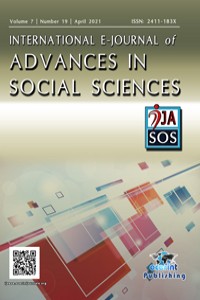Abstract
References
- Big explanatory dictionary of Russian language (2001) (Russ. ed.: S. A. Kuznetsov. Saint Petersburg) (In Russian).
- Dal, V. I. (1978). Explanatory Dictionary of the Living Great Russian Language (In Russian).
CONCEPTUAL FRAMEWORK OF MULTI-STRUCTURAL LANGUAGES IN A COMPARATIVE ASPECT (THE RUSSIAN AND ENGLISH LANGUAGE AREAS)
Abstract
The present study focuses on the comparative description of the concepts of the unreal world in Russian and English. The research of mythological and religious ideas about the unreal world which is specific to speakers of two languages has been taken to study in ethnography, folkloristics and culturology. At the same time, the linguistic study of this phenomenon was sporadic, both in the conceptology and in comparison of multi-structural languages. The above-mentioned determines the relevance of this srudy, which attempts to define the nature of the concepts of "angel" as a subject of the unreal world, which are peculiar to native speakers of Russian and English. The lexeme αγγελος was borrowed by the Old Russian and Old English languages areas as part of the cult vocabulary. Originally, the functioning of the mentioned lexeme in both languages was limited to the Holy Scripture, in the texts of which this lexical unit was used in two main meanings: ангел 1 / angel 1 ‘according to religious ideas, a supernatural disembodied creature, a good spirit’ and ангел 2 / angel 2’according to religious ideas, a supernatural disembodied creature, an evil spirit'. These lexical-semantic variants are an example of a quite rare linguistic phenomenon of enantiosemy – a type of antonymy, when as the antonyms act not separate lexical units, but lexical-semantic variants of the same word. The lexical compatibility of these lexical-semantic variants contributes to their distinction in the texts of Holy Scripture. In addition, in the Russian texts of the Holy Scripture, the lexeme angel has another lexical-semantic variant, which serves to denote John the Baptist. Further based on values of the lexemes ангел 1 / angel 1 the new lexical-semantic variants were developed in both languages. They were semantically identical and differentiated in meaning. The structural comparison of the intra-word semantic paradigm of the lexemes ангел / angel clearly illustrates the thesis that the measure of polysemy of the same word is distinct in different languages. The linguistic and conceptual analysis of the imagery of the language of the Russian classical poetry made it possible to identify some of the motivational features underlying the name of the angel as a subject of the unreal world, and therefore to reconstruct the approach of human thought to this phenomenon, as it was when the word was created.
Keywords
lexical-semantic variant synonymy enantiosemy, concept conceptual framework multi-structural languages
References
- Big explanatory dictionary of Russian language (2001) (Russ. ed.: S. A. Kuznetsov. Saint Petersburg) (In Russian).
- Dal, V. I. (1978). Explanatory Dictionary of the Living Great Russian Language (In Russian).
Details
| Primary Language | English |
|---|---|
| Journal Section | Makaleler |
| Authors | |
| Publication Date | May 7, 2021 |
| Submission Date | February 1, 2021 |
| Published in Issue | Year 2021Volume: 7 Issue: 19 |
Contact: ijasosjournal@hotmail.com
The IJASOS Journal's site and its metadata are licensed under CC BY
Published and Sponsored by OCERINT International © 2015- 2025


